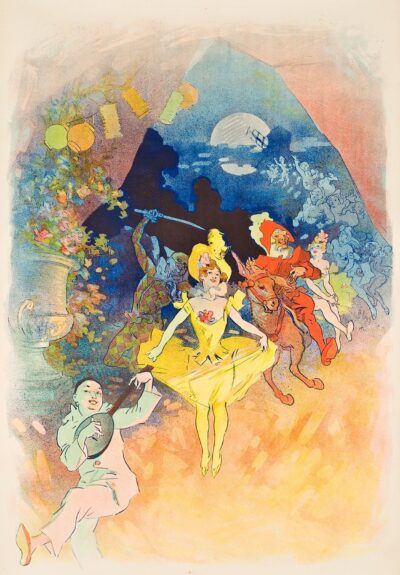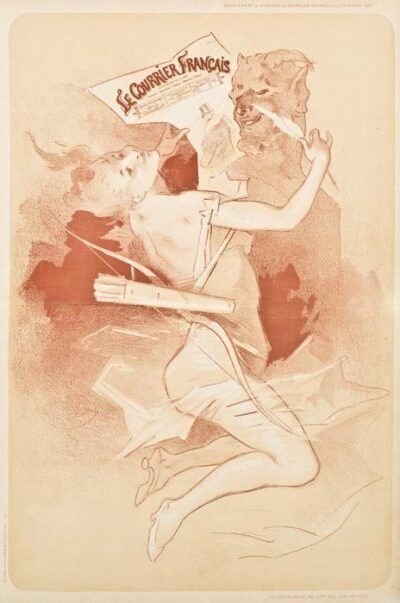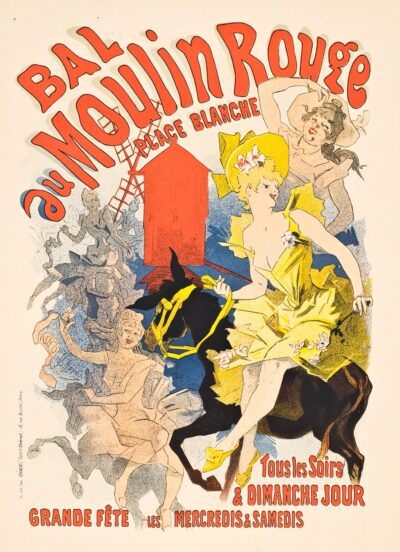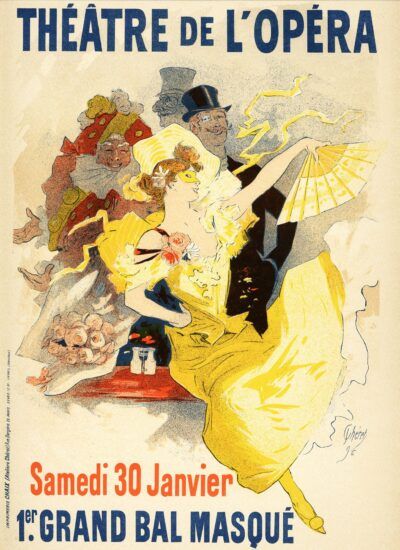Jules Chéret
(French 1836-1932)
Biography
Jules Chéret is regarded as the father of modern lithography. He created not only a new art form but a new industry as well. His training as a lithographer, superb draftsman, and his innate sense of color enabled him to raise the technical and esthetic levels of the poster to new heights of artistic sophistication.
Large outdoor posters appeared for the first time in the last half of the 19th century, as the street had become the common man’s art gallery. This changed life in the streets of Paris forever. Jules Chéret was born in Paris May 31, 1836, the son of a poor typographer. He attended the Ecole National de Dessin and spent his Sundays sketching and studying paintings in the Louvre. While in his twenties Chéret made two trips to London to seek work, as he had been designing book covers and posters for operas, circuses, and music halls. Chéret’s was introduced him to Eugene Rimmel, a famous perfume manufacturer and philanthropist, and it became a turning point in the artist’s life. Rimmel, over a period of time, became Chéret’s patron and together they traveled through Europe and North Africa. When Chéret was thirty years old, Rimmel financed the setting up of a printing firm in Paris. Chéret purchased the latest machine from England and had large lithographic stones made especially for him.
The illustrated poster was virtually unknown in Paris as an outdoor advertising medium. La Biche Au Bois (The Doe in the Woods) 1866, the first effort of Imprimerie Jules Chéret, was an enormous success. Chéret’s career was launched and a new art had come of age. Between 1866 and 1881 Chéret perfected his style and technique. He used successive stones of red, yellow, and blue followed by a fourth stone for an overlay of transparent tints. It is said that “his miracle” was in adapting the former heavy, cold, and somber lithography to the delicate, powdery, and fluid grace of pastels. By the turn of the century he had produced an impressive collection of poster designs. Chéret’s first official recognition was when he won a silver medal at the 1878 international Exposition and a gold medal in 1889. The same year an exhibition of approximately 100 of his posters, lithographs, drawings, and paintings were shown at the Theatre d’Application. The most eminent critics set their seal of approval on his popular success. In 1890 he was made a Chevalier of the Legion d’Honour with a citation which called him “creator of an art industry science 1866, by the application of art to commercial and industrial printing.” He was later promoted in varying levels up to the highest rank, a Grand Prix, at the Universal Exhibition in 1900. Since Cheret did not submit his works to the salons, nor show in galleries, his paintings and drawings were primarily acquired by friends and patrons.
In 1912 Chéret was honored by the Louvre Museum with a retrospective exhibition at the Pavillion de Maison. The Musee Jules Chéret was founded in Nice in 1928. A large collection of Chéret’s work also hangs in The Hermitage Museum in Russia. From his humble beginnings, he had reached the pinnacle of fame in art and in an industry he created himself. The greatest artists of his time were his friends and admirers, including Monet, Degas and Seurat. In addition, artists including Toulouse-Lautrec, Steinlen, Willette, and Legrand, admired and accepted him as a leader in the field of advertising art.
Chéret died in September 1932 at the age of 96. In 1933, the Autumn Salon in Paris paid homage to the artist and his tremendous accomplishments.
-

Musée Grévin
Original price was: $9,200.$4,600Current price is: $4,600. -

Le Courrier Français
-

Folies-Bergére: Emilienne d’Alençon
-

LA COMEDIE
-

BAL DU MOULIN ROUGE, PLACE BLANCHE
-

LE PUNCH GRASSOT
-

THÉÂTRE DE L’OPERA
-

LE PAYS DE FÉES: JARDIN ENCHANTÉ
-

Jardin de Paris
-

Théâtre de L’Opéra
-

Quinquina Dubonnet
-

Théâtre de L’Opéra